Preparing for a Winter Snowstorm – Basic Supplies for Power Outage
Here are a few basic supplies that you may want on-hand for ‘survival mode’ during a winter snowstorm and associated power outage situation. These are very minimal considerations. But they at least should provide some comfort and peace-of-mind. This will hopefully get you thinking about other supplies too.
Preparing For A Snowstorm – Important Supplies
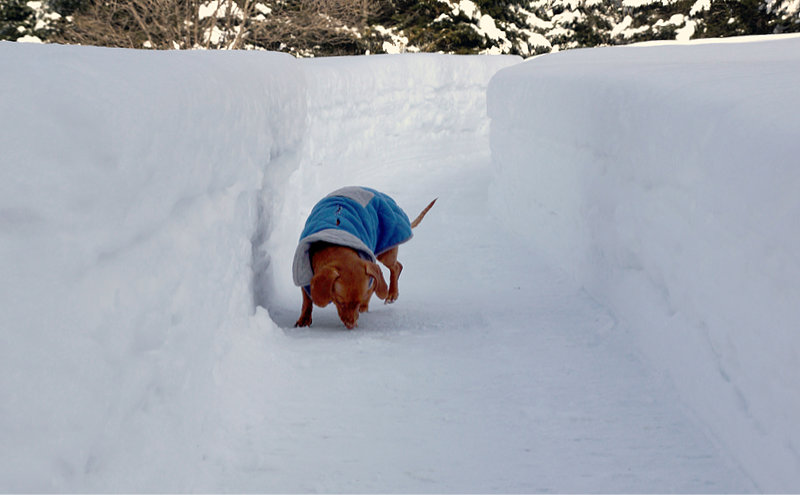
Having lived in the northeast (New England – currently New Hampshire), I certainly know about winter snowstorms. Surely many of you also live in regions where you get snow during winter.
The thing is, a winter snowstorm can be dangerous. Instead, lets make it tolerable. Even cozy. In my opinion, there’s nothing quite like watching a raging snowstorm through the window of a warm cozy home. I’m sort of a weather geek, so I find it, well, ‘fun’…
A winter snowstorm will cause especially bad problems when:
- The snow is heavy and wet as opposed to light and fluffy
- Snowstorm is accompanied by high winds
- Sleet or Ice accumulation anytime during the event
If the snow is anywhere near ‘heavy and wet’, watch out below! Down come the branches… It’s even worse if the snowstorm is during the late Fall season with leaves still on the trees!
Anyway, I’ve experienced snowstorms with many feet of light and fluffy snow in a single event without any bad repercussions. On the other hand, it doesn’t take too terribly much ‘wet and heavy’ snow (or ice) to bring down power lines. The worst is a snowstorm that dumps a foot of heavy wet snow. Why? Because it’s wicked heavy! You’re about guaranteed to lose power as trees and tree limbs come down over power lines. And it might take a long time before crews get to your neighborhood.
Supplies For Power Outage In Winter – Hunker Down…
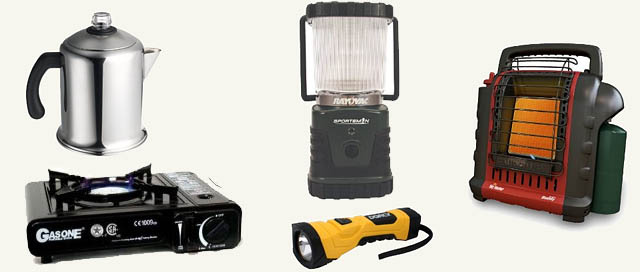
Priorities, right? I could list pages of supplies. However, lets focus on the priorities here.
Here are some higher concerns for a snowstorm situation accompanied with a power outage
- Heat and staying warm (it’s winter, so I assume it’s cold outside)
- Water (if you have well water, otherwise you’re fine on municipal)
- Emergency Lighting
- Food (should be a no-brainer)
- Ability to Cook some food, percolate some coffee, make hot chocolate!
- Portable Radio for weather and news
Heat – Keep House Warm During Winter Snowstorm Power Outage
This reminds me of a winter snowstorm event not long ago in Texas that devastated the area and caught millions of people off-guard. Snow and Ice. It was so bad that the power was out for weeks in many places. And it was very cold outside! The storm was an unusual event for that region. But, it happens. People were desperate to keep their house warm. They were even burning furniture in their fireplace (if they had one). So, how to mitigate that?
Generator
First thought – a generator. At least a portable generator powerful enough to run your furnace, fridge, freezer, and well pump (if you have one). Bear in mind that most all well pumps require 240 volts, so you will need a 240 volt generator output (so, know that when choosing one).
Portable Generator
Minimal setup is simply running an extension cord from a portable generator that you haul out of the garage and place outside. It may be easy to simply plug in ordinary appliances. However, you may have to get a bit more creative to jack it into your furnace (depending on your furnace). If you know electricity and you’re a do-it-yourselfer, it’s not that difficult. However, consult an electrician if you need to – who will probably recommend the suggestion in the following paragraph.
[ Read: Best Extension Cord For Generator | Heavy Duty Gauge Recommendation ]
[ Read: Cold Weather Extension Cord That Stays Flexible & Won’t Crack ]
Generator with a Transfer Switch Kit (multiple circuits)
Next level up is installing a transfer-switch kit for an outside generator to selectively power electrical circuits of your choosing from your utility electrical panel. Here’s an example of a 6-circuit transfer switch for a generator up to 7500 watts. I installed one of these at my dad’s house a number of years ago…
Reliance Controls 30 Amp 6-circuit Pro/Tran
(view on amzn)
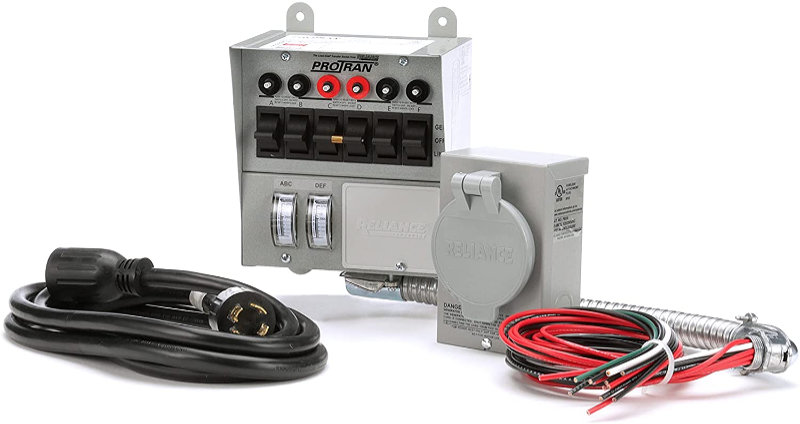
Whole House Generator
A ‘whole house’ standby generator. This is obviously expensive, and you need a big generator. These typically will automatically come on when the power goes out, and obviously, power the ‘whole house’. I believe the most popular brand in this arena is Generac.
Buddy Heater
A propane space heater. The Buddy Heater brand is extremely popular for a portable space heater. I’ve had one for years. It won’t keep your whole house heated, but it will do a decent job in a room. The bigger model will heat more space.
4,000-9,000-BTU Indoor-Safe Portable Radiant Heater
(view on amzn)

During the winter, the immediate concern will be heat. This particular heater will safely and effectively provide plenty of heat for a room. You will have bigger problems if the outdoor temperature remains consistently below freezing while at the same time the power outage lasts much longer than a day (pipes will begin to freeze and may rupture), but this heater will provide a first level of defense for a short term survival situation.
[ Read: Buddy Heater Run Time | 1-lb & 20-lb Tanks ]
Wood Stove – Pellet Stove – Fireplace
You either have one or more of them, or you don’t. But if you do, then always keep an adequate supply of wood or pellets! No doubt you already do (have a good supply) if you normally heat (or supplement heat) your home with a wood or pellet stove.
However, if you have a fireplace, chances are it’s for ‘looks’. And you may not have any, or hardly any wood ‘fuel’ for it. Maybe a good idea to have some more on hand? Just know that an ordinary fireplace is not an efficient way to heat. Lots of heat from the room/house gets sucked up the flu. But it’s better than nothing! It will put out radiant heat.
[ Read: Fireplace Reflectors Improve Wood Burning Heat Efficiency ]
[ Read: How to Run a Pellet Stove During a Power Outage ]
Oh, IMPORTANT! Please make sure you have at least one carbon monoxide detector in your home (battery operated!). I’ve been using this one which powers from the AC outlet AND battery power backup:
First Alert Dual-Power Plug-In Carbon Monoxide Detector
(view on amzn)
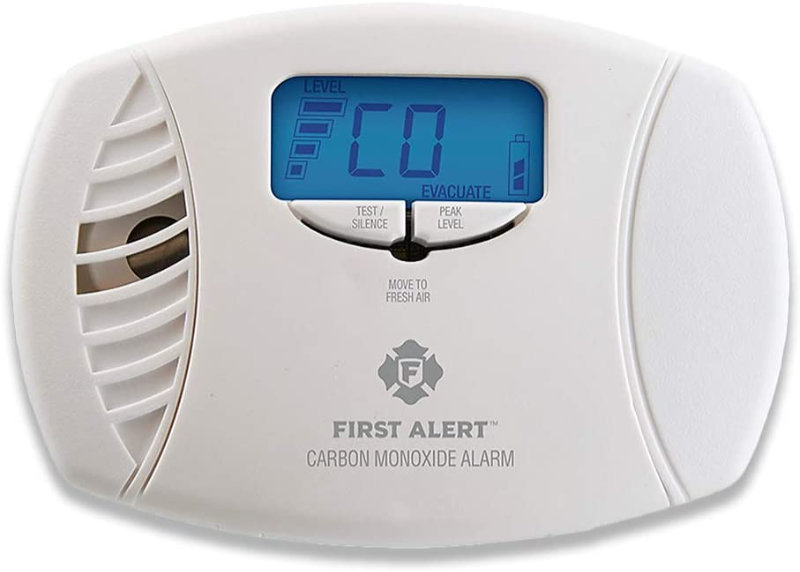
[ Read: Carbon Monoxide Poisoning Symptoms ]
Warm Blankets – Enough of Them For Everyone
If you can’t get your house as warm as you want it (no power), warm blankets will be pretty important. Sure, you could keep wearing a warm jacket and warm clothes. But it will sure help to sleep at night if everyone had a warm blanket. Or, for cozying in a chair…
Wool or Fleece? Either is good.
[ Read: Warmest Blanket Material For Winter — Fleece vs Wool ]
Water
So, if your water source is simply from ‘the street’, your municipal water supply will be fine during most any short or mid-length power outage. The city/town is equipped to handle power outages and keep the pumps running.
However, if you’re on a well pump (like I am), then you need to come up with a plan. Most well pumps are 240 volt. So, a generator with a 240 volt output. It could be integrated into your grid box via a transfer switch as exemplified above.
Additionally, especially if you have a well, you should always keep a supply of extra water above ground. Maybe a 55 gallon drum? That’s what I do…plus some smaller jugs for storage and transport of potable water.
[ Read: 55 Gallon Water Storage Barrel | How-to Clean & Store For Emergency ]
[ Read about: Aqua-Tainer 7 Gallon Water Containers ]
Emergency Lighting

You’ve got options here…
Each bullet point is associated with an article on the blog:
Another tip is to use landscape solar lights. Simply set them outside during the day for a charge, and then use them at night inside.
[ Read: Charge AA Batteries – And More – With A Portable Solar Panel ]
Food For 2 Weeks
Again, referencing that snowstorm in Texas that left people without power for weeks (and that’s just one example of many!)… Wouldn’t it be a good idea to have “at least” enough food in your house to feed the family for two weeks?
No need to get into how to do that, because it’s a no-brainer. Just get-er-done.
The Means to Cook Without Power
Although many foods do not require cooking, there’s nothing like a hot meal during a winter snowstorm. What about heating up that percolator for a hot cup of coffee because your electric drip coffee maker won’t function? Or, hot chocolate anyone? How are you going to do all that during the power outage?
Butane Cook Stove
Well, if you have a gas stove, you’re already all set. But if you don’t, then what? Here’s one recommendation (I have one of these – even though I do have an LP gas stove/oven) (Great for other scenarios too).
GASONE Portable Gas Stove
(view on amzn)
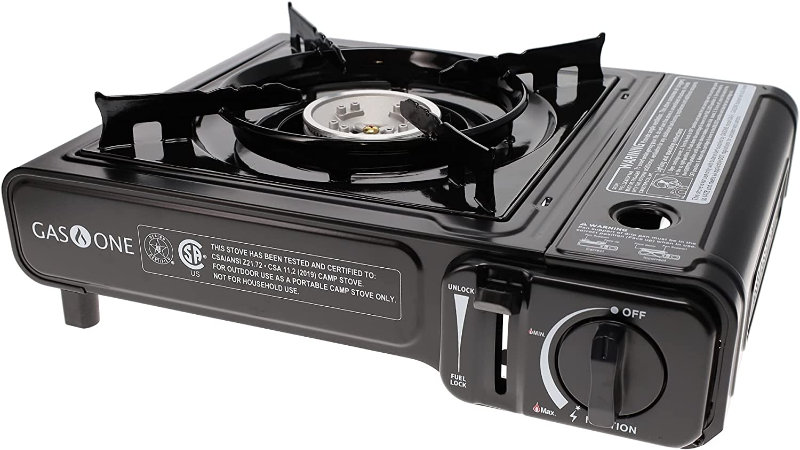
This portable butane stove will do the job. I like the fact that it’s flat and will support a heavy or fairly large pot, whereas some other portable stoves are upright and precariously support a pot or pan. This is one of the portable stove’s that I own, and I have been very happy with its performance.
Be cautiously aware that any burning flame will put out some carbon monoxide. Butane though, like the one listed above, is safer for use inside. Still, use common sense.
[ Read: Single Burner Butane Stove Safer For Cooking Indoors ]
Coffee Percolator
How many of you have thought of this one… most coffee drinkers use ‘drip’ coffee-makers to make their coffee – which require electricity. So, to make that cup of coffee with a portable gas stove, you will need a percolator.
Farberware Classic Yosemite Stainless Steel Percolator
(view on amzn)
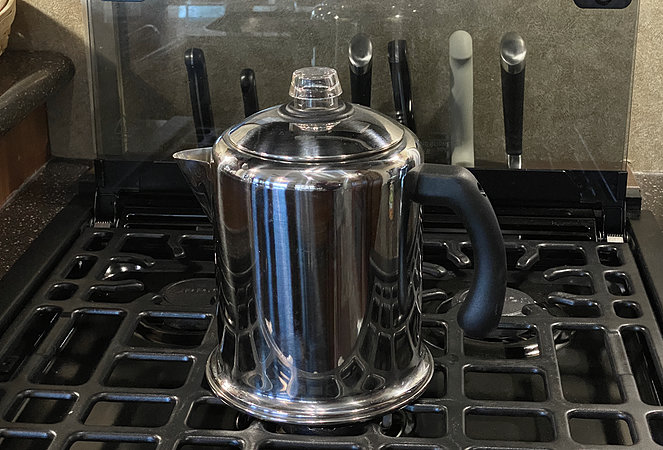
[ Read: 10 Things People Will Miss Most Without Electricity At Home ]
Portable Radio for Weather and News
Here’s a suggestion. A dual-powered (AC and battery) weather alert radio that has a built-in AM/FM radio too. That way, not only will you get NOAA weather alerts, but you can also listen to local broadcasts of news and information. This will keep you up-to-date with what’s going on out there in the aftermath of the snowstorm and power outage. Important!
I have several. However I do like the Sangean CL-100.
[ Read: Best Weather Radio – The Reason I Switched Back To This One ]
[ Read: NOAA Frequencies and Weather Radio Station Near Me (Maps & List) ]
If you’re into radios, here are a few additional articles that may interest you:
Best Portable Shortwave Radios
[ Read: Winter Survival Gear For Your Car ]
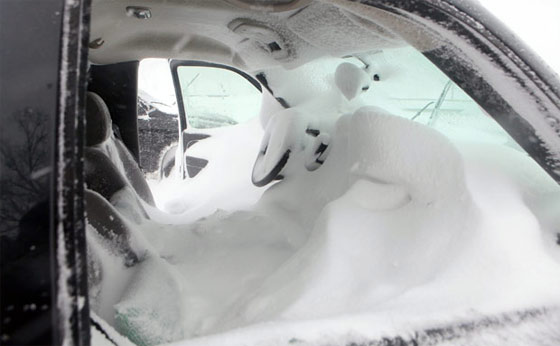

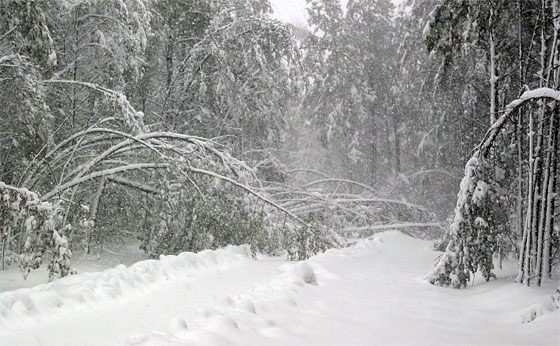
I find it interesting that DURING every disaster (i.e hurricane, weather storm, Covid, Wildfires etc.) those of us that have always planned ahead are not considered “crazy prepper loons” but as soon as things get back to normal the non-prepared return to their JIT mentality and the negative “prepper” labels reappear. They never seem to learn that self-reliance is a way of life not just seasonal, which I guess will be a blessing for us as it will “cull the herd” when the SHTF becomes a long-term, extended event.
RC
Truer words were never spoken! We are just getting over a big storm up in my neck of the woods and folks were stuck on the highways for hours, after being told not to drive on the roads of course by the police! Many moaned that they had no water, nothing to eat or had to keep their cars running to stay warm as they had no blankets or proper clothes for blizzard conditions. It seems you can’t fix stupid but if even a small percentage learn from this storm it will be good.
Reply to RC: I am old enough that I really do not care what other people think about me. After the Nat Geo program years ago, they put the label: “prepper” into a bad light. One thing about being old is having the experience to go through outages, shortages and bad storms. If one does not prepare after going through bad times and situations, shame on them. I do not expect the young to listen to me though I am surprised at the high number of young people that do ask me about things these days.
Calirefugee,
it has not been that many years ago.
i’m told that they did not have rural electricity in our area until the mid 50’s, until the REA’s and rural water came along. MIL would say that they had one five watt light bulb in the house and they would have to strike a match to see if it was on : ) the old house is barley standing now and still has no indoor plumbing.
what we do now as far as the preparedness lifestyle was considered normal everyday life for the very rural communities then. i moved here in 1980 and they still had partyline phones, no crap.
technology is great, especially in the healthcare fields and others, but it has also made us soft, the old knowledge of “how to” is being, and has been lost.
Ha, i would love to sit back and watch the BLM-LBG whatever type people trying to rub sticks together for a fire.
Cali,
I’m with you. I think the true plot of the series was to label self-reliant people as paranoid freaks and it was scripted with actors not actual “preppers”. There is know way a sane person that truly prepares for the future would go on national tv and advertise to the world their location, supplies, plans, firearm inventory etc.
I’m also too old to care about labels but I’m still amazed at stupidity.
Good info Ken,
I routinely heat with wood, 2 different wood stoves. I have zero concerns leaving the house with a fire going, it’s normal. There are many folks who may have a wood stove or maybe an open fire place. Most are fearful of leaving the room, much less leaving the house. Fire is a fabulous source of heat. I encourage folks to use their heating systems, woodstove or fireplace. Get used to using it. Yes, you must have respect for fire. When ya think about it, there is a large and powerful flame within your furnace. You just don’t see it. I’m talking NG or LPG.
Woodstoves are well built. Likely better built than a typical gas furnace. A properly installed and well maintained woodstove/chimney, is safe. Whether there is a chimney fire or not. If you clean your chimney often, you should never have a chimney fire. They are designed to withstand a chimney fire, but I don’t want one.
In my experience, each woodstove is unique. The damper adjustment, type of fuel/wood, etc. The only way you become comfortable with it is to use it. Learn to adjust the damper according to temp/wind-chill/size of logs, etc. You’ll get the hang of it. Soon, it’ll be second nature. Woodstoves do not respond instantly to damper adjustments. Give it 20-30 minutes. I adjust the damper in small increments. Don’t get in a hurry.
They make great inserts for open fire places. Basically turns it into a wood stove. Much more efficient. With wood heat, YOU are in charge of the fuel.
I know this is not the article to make this comment, but I’m in a survival mode so to speak. A few days past, I stated that my wife had passed away, and have had many comments from my MSB Family, and just wanted to say Thank You to all of you for your comforting messages. God,Time and Friends do help take the edge of pain off some what. Thanks Again, Trekker Out
Mountain Trekker, I am so sorry for your loss! I pray for your peace and comfort. Yes, one day at a time and know that there is always an ear or two tuned in for listening when needed. I am sorry I missed your original posting…we have been super busy with a major change that I am not free to speak about just yet. I am never too busy to add anyone to my daily prayers though. Please take care of yourself.
Don’t forget the fire extinguisher and fire blanket ( I have both near the wood burning stove-embers hate me ! If I hear a snap or pop from the fire I know that little bugger is coming straight for me!)
After last years Ice Storm of Valentine’s Day of 2021, (in Oregon and Texas) A poster talked about using eco fans to circulate the warmer air around the room. I ordered one and am thinking of ordering an additional one to go along with the 2nd Buddy heater I picked up. I forgot who posted about this but many thanks to that poster because I never heard about these types of fans before. When this happens again, my wife will be a bit more comfortable with the ability to circulate warmer air within a room.
For my critters, I filled nalgene water bottles with hot water and wrapped them in towels and fleece throws and placed these in pet beds. I spent a lot of time cooking on the gas stove and heating water in addition to making soups, stews and boiling up some eggs. My wife got tired of eating canned soup and drinking tea or coffee. Our power was out for 4 days and 5 hrs last February. I still went to work and came home for most of that time.
A little over a week ago we experienced a heavy wet snow and high winds. Lost a lot of pine trees and we were blocked in for a couple of days until the downed trees could be removed. We lost power for two days but had just installed a ‘whole house’ generator so it wasn’t as taxing as the times I had to manage portable generators. Hit with another winter storm Sunday. Didn’t get a lot of accumulation this time but did get some ice and high winds again. Luckily the trees weren’t loaded like before. Now they are forecasting another one over next weekend and maybe another after that. Whew! You had good, sensible, recommendations that would be beneficial for everyone to pay attention to. Doubtless if you are on this site you already do. But most don’t. They sit and wait for the government to “fix it”. One addition I would recommend gets some consideration is a ‘solar generator’ big enough to keep cell phones charged and maybe even run the microwave, coffee maker, and even the frig.
Cell phones are easy to keep charged, and for not a lot of money. Larger appliances such as a microwave or full-size fridge not so much.
For cell phones, I use an Anker Power Core II 20000. It’s good to charge a phone about 4 or 5 times. This model is considered “old school” these days (USB-A outputs vs the newer USB-C outputs) so some may be interested in looking at the newer models available.
For larger appliances, there are two factors to consider. The capacity of the inverter (a device that converts DC battery power to 120 Volts AC – the same as a wall outlet) and the capacity of the battery.
Microwave ovens can draw 1500 watts, and not all “solar generators” come with an inverter of that capacity. A full-size fridge usually doesn’t consume as many watts, but the power draw is for a longer period of time, making battery capacity important.
I own and use the Bluetti brand, but the Jackery brand appears to be as, if not more, popular. The reason I chose Bluetti is because at the time of my purchase, their battery technology was superior to the Jackery.
Some models to consider for a microwave/fridge:
Bluetti AC200P
Jackery Explorer 1500
The *one* brand I do NOT recommend – although it seems they aggressively advertise everywhere so many will have seen the ads – is Patriot Power. These units are *very* overpriced, and come with a *very* small battery that won’t run your appliances for as long as you’ll need.
Your comment reminds me of a related article:
Jackery versus Gas Powered Generator
Having just went through a 9 day Power outage due to storms I agree with most of what Ken says. I highly recommend LED solar lanterns over either candles or hurricane lamps. I have both but the fire danger can be bad with them. We had roads that took Days to clear so fire trucks couldn’t even get to some areas . My preference for coffee is a press as opposed to the coffee pot but to each their own. The main thing is to be prepared. Do lights out weekends too practice. You don’t want to find Holes when it counts
This article caught my eye as we are in the middle of a sizable winter storm. No I do not have to run anywhere to pick up anything, but it still creates additional workload. Lots more snow removal, extra bedding for animals, a bit more food (increased calories) to help them manage colder zero temps, and breaking frozen water and replacing.
The fact that surprises me the most? Even in the north people get in their vehicles and drive into these messes with NO regard for their own well being. Keep some supplies in your vehicle people! You might need to step outside into that mess at some point in time!
And for the home, I also feel a good solar power backup for your phone is important or a couple of charged battery backups. As well as a reminder to people how to open their garage door without electricity….although that one is just funny. Time to suit up and get back outside.
I thought of something else that isn’t critical but certainly does provide some comfort – a two-meter ham radio. I was able to talk to neighbors in the area, checking on conditions and each other, throughout both recent storms. It was comforting and I looked forward to the ‘nets’ and passing information back and forth. Just a thought.
Whydah,
When there is severe weather forecasted for our area our Ham radio club will set up a monitor schedule on our local repeater so people can check in with reports, request assistance or relay and get information. Where I live there is no cell service for several miles so if the landline goes down our only comms are on our ham radios.
Living in the Berkshire Mts, I’ve been prepared for bad weather, had everything fairly comfortable, That is until Covid came along and my wife had option to work at home.(that was a big plus for us)
However as life would have it one day the power went out in the night and she didn’t want to go to work but felt she had to because of her position. I sure didn’t want her to go cause of the Covid risk. So I talked her into letting me digout this old 400w inverter I had bought 15 years ago to run a jig saw at my hunting camp.
I had 1 year old battery from my John Deere garden tractor that was always charged up for bench work in the garage, shoot I think it only had 330cca. Anyway, I brought all that into her home office, put the battery on a little rough tote with the inverter and unplugged the power strip she was using and plugged it into the inverter.
I told her she might be good for an hour or two, cause there was a little cooling fan in the inverter and I don’t know how long this little battery would put out!
You know, that dang thing went 6 freeking hours and was still going when she was done for her day. She even ran the laser printer a few times! 400w inverter with a 1 y/o $25 tractor battery, ha! Go Figure!
– epo3,
DW has a small business, a weekly newspaper out here in the hinterlands. We had an incident here a number of years ago, a school bus backing up and took out power to the office. The school had only a small generator, only about 2.5 KW and not enough power to share with our office.
At the time, I had an old 350-watt inverter and a late-90’s Chevy van. I parked it as close to the front door as I could. Ran a little 50-foot extension cord inside, plugged several of the *3-way* taps together for my power distribution, and ended up plugging two desktop computers, two laser printers, an LED lamp, a 200-watt waxer, and a box fan (it was summer) into that little inverter. The paper was turned out on time. Monitored the power usage in the van, started it twice in the 8 hours I ran that system. No problem.
– Papa S.
I would recommend a full tank of compressed air for winter preparedness. I made an attachment for my hose connection that allows me to connect air and blow out my water hose. Now when I water the animals, I can blow out the water before it freezes. I also have a ¾ inch reducer that I can hook to an outside water spigot and blow the water out of my system to prevent it from freezing in the walls and bursting. If the folks in Texas had such a device last winter, they could have back flushed their water systems to prevent them from rupturing in the cold weather.